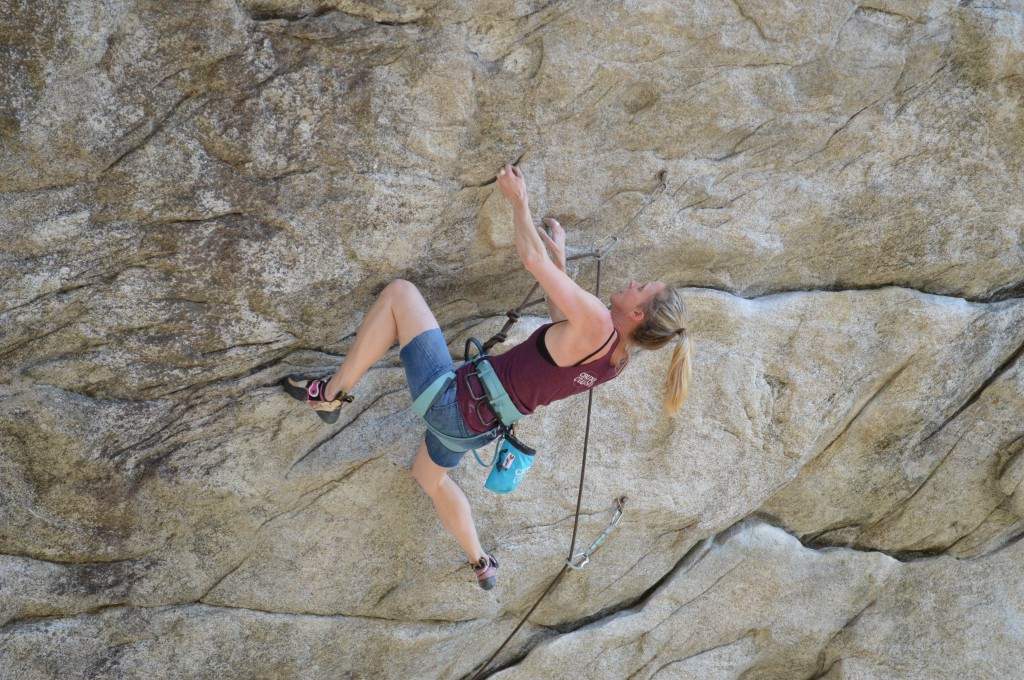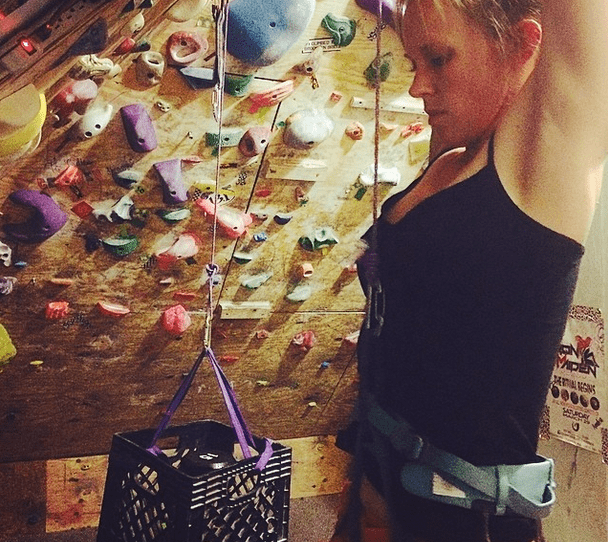The rock climber training manual: In the 7 years that I’ve been climbing, I’ve followed exactly zero training plans. It’s not that I didn’t want to get better at climbing, or that I doubted the training plan would work. The factors preventing me from training, any longer than a day, stemmed from a combination of motivation, commitment, and time management…that is, until reading the Anderson brothers’ Rock Climber’s Training Manual: A Guide to Continuous Improvement. Their approach to climbing and training worked for me for numerous reasons.

Putting my training to the test on Ginseng Route (5.12c) at Shagg crag, Maine.
I went from being unable to realistically attempt the crux moves on 5.12s, unable to even make a single movement between the rungs on the campus board, and being able to do a max of three 10 lb bicep curls to sending or close to sending my three 5.12b/c projects, loving the campus board, pumping 25 lb bicep curls – all within 4 months. Here’s why the Andersons’ approach worked for me:
Check out what Katie Ives says about her carrier.

You can purchase a copy of the Training Manual at their site.
Training Manual: Efficiency
In the past, I swore off training plans using the excuse that I was too busy – yet thought I could play around at the climbing gym a few nights a week and magically climb my way into upper 5.12 territory. What sold me on training was the recognition that my life is too busy not to train. As the Anderson brothers write, “For those who don’t have 40 hours per week to climb, training is by far the most time-efficient way to improve; for working adults with families, it’s the only way to improve.”
While there is beginner, intermediate, and advanced levels of training within The Rock Climber’s Training Manual, following a blend of the beginner to intermediate plan is completely feasible while also working a full-time job and managing family and social responsibilities. Following this plan, I trained or climbed outside 3-4 days a week, with time to still have a life outside of training.

One of my least favorite parts of training – weight-assisted finger boarding – but worth it in the end!
Periodization
Periodization is a “strategy for physical training in which exercises are carefully varied to avoid plateaus and create synergies that result in a performance peak at a predictable time.” In other words, periodization forces you to spend time on your weaknesses, which ends up being a really good thing for your overall climbing. Having never followed a training plan, I have some very entrenched weaknesses. My friends would joke that I found a way to do every move static – but that was really because I had zero power or strength, outside of my fingers. The very thought of doing bicep curls made me want to puke.
Somehow periodization made the pill easier to swallow because I knew that I only had to push through something like strength training for a few weeks before I got to move on to something I’d enjoy more. The Rock Climber’s Training Manual covers six areas in periodization: base fitness (2-4 weeks), strength (3-4 weeks), power (2-4 weeks), power endurance (2-4 weeks), performance (3-4 weeks), and rest (1-2 weeks). As an added bonus, periodization reduces the likelihood that you’re going to get hurt, unlike my standard pre-climbing trip approach of doing long gym routes over and over, never working power, and then going outside and blowing a pulley.

The training allowed me to make dynamic moves, something I’d always stayed away from in the past. (Photo credit: Mike Bowsher).
Data-Driven
The Anderson brothers’ training plan encourages you to take notes on each training session. I guess this is where the nerd side of me comes out, but I love tracking my progress and getting scientific about it. You get yourself a cute little training book, decorate it all up, paste in those pictures of your goal climb to remind yourself of why you’re doing bicep curls even though you hate them, and then let the data motivate you toward achieving your goal.
I love seeing what I’ve done, where I’ve been, and where I’m going. Seeing that I went from 10lb bicep curls to 25 lb bicep curls ignites a sense of pride.
When I compare where I started on the campus board – literally barely able to move up one rung, to monkeying up all the way to the top, I can literally chart the progress that I’m making. It’s also effective because of the precise control over each exercise, that you’re tracking by weight added or removed. This prevents a climber from making too large a leap in their training, plateauing, or ending up on the injured list. On top of it all, all of these gains are made within only a few weeks.

Flesh for Lulu (5.12a/b) at Rumney is one of the routes motivating me through my training.
If I were questioning whether the training plan was worth it at all, I only had to get on Pump Up the Volume (5.12b) and walk through the crux that I hadn’t even been able to attempt last spring, to know that the training plan was successful. Gaining the ability to make powerful, dynamic movements between holds justified the training plan for me. And the best part is, that I’m just hitting my performance peak…
As the Anderson brothers point out, the key to long-term improvements in climbing isn’t how many tries we take on our projects, it’s how many macrocycles we complete (each revolution through the 4-month cycle is called a macrocycle). While this isn’t novel information at all to trainers, coaches, and sports scientists, it still seems to really blow climbers’ minds. So, after I finish sending my projects and I settle in for winter, you better believe that I’ll be starting up my second macrocycle, aiming for 5.13 next year.
If you’d like to learn more about Michael and Mark Anderson’s approach to training, you can check out their site and order a copy of their book here: http://rockclimberstrainingmanual.com/.
Climb on! ~Cate






